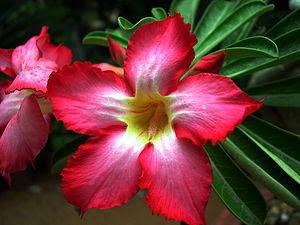 |
| Garden flower (Photo credit: Wikipedia) |
 |
| English: The Star Jasmine, Confederate Jasmine or Trader's Compass ('). (Photo credit: Wikipedia) |
 |
| English: Perennials border in Summer. (Photo credit: Wikipedia) |
 |
| Australian native (NSW, QLD, VIC) - new 'resident' in my garden Small perennial plant (30-50cm) of Campanulaceae (Lobeliaceae) family (Photo credit: Wikipedia) |
 |
| English: Blue wild flower of Cichorium intybus Français : Fleur de Chicorée sauvage (Cichorium intybus, parfois appelée Chicorée intymbe) Magyar: Mezei katáng (vad cikória) Português: Flor de Chicória (Cichorium intybus) (Photo credit: Wikipedia) |
When you buy a new house you want to have an amazing garden where your children can play, and you can sit back and unwind. A garden is one place where we feel we are one with nature, and can enjoy the small pleasures of life. But without a few container plants and lots of flowers, a home garden is not complete. Before you choose the plants that you will grow in your home garden, walk around the neighborhood, and take note of what kinds of plants are already growing. This will give you an idea of what grows well, and how it will look in your own garden.
When planning your garden, be aware of the blooming season of the various flowers.. Planting perennials with different blooming times will insure a garden that flowers all season long. Remember also to plan for the height of the plants, putting the taller ones in the back so they do not hide the others.
Bad soil conditions, or wrong nutrients can keep flowers from growing well, and could even kill them. Areas that don't drain well, or where water pools after a rain, should be avoided when planting, as the roots can root. A soil with a pH range of 6.0 to 7.4 is best for most annuals. Before you start work with your garden beds, test the pH with a home soil test kit. If the pH is less than 6 or acidic add lime sulfur as required to bring the pH up. However, if the pH is above 7.4 you will want to add ammonium nitrate. After the pH is in the proper range, spread 2 to 3 inches of compost, and cultivate it at least 8 to 12 inches deep. This will create the best possible environment for your new plants.
Give some thought to putting annuals in your perennial garden. Annuals give you season long color, they are easy to propagate, they can be cost effective, and annuals provide that first season interest. If you're just starting a perennial garden annuals are a great choice to fill in gaps. A new perennial garden can take a couple of years to mature, and can be quit expensive to fill out in just one year, so by adding annuals you can have a very pretty garden even in the first year. Annuals will help to fill in a garden while you wait for the perennials to mature, and even after to fill in gaps.
You need to select healthy plants if you've decided to grow annuals this year. Many people choose to grow their annuals from seed, although this process can be time consuming. Others choose to purchase their plants from a green house. While both ways are acceptable, always remember to choose carefully if you are buying from a green house.
Deep green plants will grow best, and should be sought out; a spindly plant in a cell-pack, indicates that this pack has been stored for too long, and should be avoided. It is also wise to check for signs of disease by examining the leaves and stems and even removing the plants from their pots to check the roots. Roots should appear firm and white, and contain no spirals or kinks.
The up side is garden centers are happy to share their information about soil, sunlight, water, and wind shielding requirements for each plant with their customers.
When planting flowers, it is important to remember to follow the instructions on the tag for the plant. Always consider the conditions in which you want to grow the plants, be sure to buy plants that will thrive in the conditions you have in mind. A plant that loves sun will not do well in a shady area, and you will only be disappointed with the results.
Spring bulbs work well in a perennial garden. They are the first of the season to bloom, and when they finish some of your perennials will be starting to bloom, and others are filling in and hiding the soon to be dormant foliage of the bulbs. This is a great way to extend the color in your garden well into the summer blooming season.
For a really natural look you could arrange your bulbs randomly. By tossing the bulbs and planting them where they land, with small adjustments for spacing, your garden will have a much more natural look, as if Mother Nature had planted them herself.. Randomized bulbs look beautiful in any setting. After the bulbs bloom the foliage will die down to make room for later growing plants, therefore, you can spread bulbs around with other types of plants for a carefree and beautiful garden.
Summer bulbs such as Dahlias are a great chose to fill in areas that need color after the early perennials have finished. Keep in mind that most summer bulbs will need to be dug up and stored over the winter. The good news is that you can redesign your garden by rearranging these bulbs the next year.
If you want plants that will do well growing against a wall as a cover, or on a trellis or arch, there are many choices including:
Clematis is a variety that produces purple, pink or blue colored, bell shaped flowers with fern like leaves. Wisteria is a hardy climbing plant that boasts lilac colored flowers that grow in hanging clusters, before the foliage sprouts. Star Jasmine, my personal favorite of these climbing plants, produces leather like, dark green leaves with beautiful white blossoms that have an unmatched, abundant fragrance.
Planting wild flowers, or simply scattering wild flower seeds around an area of your yard are both ways to take advantage of Mother Nature's treasured gifts. Wild flowers are carefree, colorful, and tend to attract bees, butterflies and birds. So planting wild flowers not only gives you an easy maintenance flower garden, it also promises to be a constant source of interesting activity throughout the year.
Follow these simple bits of advice and keep your garden in glorious bloom all summer long.
About the Author:
Luann Hays runs 2 website that offer special items for women. Go to Woozita's Wares for sexy lingerie and much more. Send Flowers Online, find fresh cut flowers, gift baskets and unique gifts. Visit http://www.woozita.com/ and http://www.flowers-online-flowers.com/ respectively, to learn more.
Read More Articles by Luann Hays
Source: thePhantomWriters.com Article Submission Service









